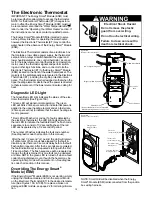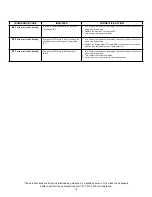
14
Operational Conditions
Anode Rod/Water Odor
Each water heater contains at least one anode rod,
which will slowly deplete (due to electrolysis) prolonging
the life of the water heater by protecting the glass-lined
tank from corrosion. Adverse water quality, hotter water
temperatures, high hot water usage, hydronic heating de-
vices, and water softening methods can increase the rate
of anode rod depletion. Once the anode rod is depleted,
the tank will start to corrode, eventually developing a leak.
Certain water conditions will cause a reaction between the
anode rod and the water. The most common complaint
associated with the anode rod is a “rotten egg smell”
produced from the presence of hydrogen sul
fi
de gas dis-
solved in the water.
CAUTION:
Do not remove this rod
permanently as it will void any warranties. A special anode
rod may be available if water odor or discoloration occurs.
NOTE: this rod may reduce but not eliminate water odor
problems. The water supply system may require special
fi
ltration equipment from a water conditioning company to
successfully eliminate all water odor problems.
Arti
fi
cially softened water is exceedingly corrosive be-
cause the process substitutes sodium ions for magne-
sium and calcium ions. The use of a water softener may
decrease the life of the water heater tank.
The anode rod should be inspected after a maximum of
three years and annually thereafter until the condition of
the anode rod dictates its replacement. NOTE: arti
fi
cially
softened water requires the anode rod to be inspected
annually.
The following are typical (but not all) signs of a depleted
anode rod:
• The majority of the rods diameter is less than 3/8”.
• Signi
fi
cant sections of the support wire (approx. 1/3 or
more of the anode rod’s length) are visible.
If the anode rod show signs of either or both it should be
replaced (see Figure 11). NOTE: Whether re-installing or
replacing the anode rod, check for any leaks and immedi-
ately correct if found.
Water Heater Sounds
During the normal operation of the water heater,
sounds or noises may be heard. These noises are
common and may result from the following:
1.
Normal expansion and contraction of metal parts
during periods of heat-up and cool-down.
2. Sediment buildup in the tank bottom will create
varying amounts of noise and may cause
premature tank failure. Drain and
fl
ush the tank as
directed under “Draining and Flushing”.
Stacking
Certain water usage patterns can cause the water tem-
perature to exceed the thermostat setting. This is known
as “Stacking”.
Stacking occurs when a series of short draws of hot
water (3 gallons or less) are taken from the water heater
tank. This causes increased cycling of the heater ele-
ments and can result in increased water temperatures at
the hot water outlet. An anti-scald device is recommended
in the hot water supply line to reduce the risk of scald
injury. Use of a mixing valve is encouraged.
Figure 11
Anode Rod
EXPOSED
SUPPORT
WIRE
PITTED
ANODE
ROD
EXPOSED
SUPPORT
WIRE
See “Replacing the Anode Rod” in the maintenance section
page 15.










































